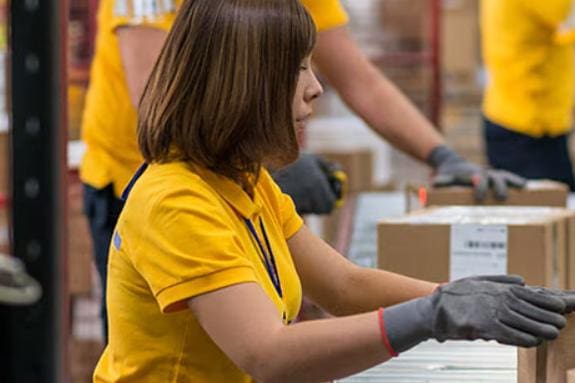In recent years, customers, employees, investors, and governments have put increasing pressure on companies to demonstrate greater environmental stewardship and social responsibility. This comes at a time when the business case for sustainable operations grows stronger every year.
For many businesses, supply chains have come into focus because they use a lot of resources and money and are frequently a source of unnecessary waste. Thus, supply chain sustainability has emerged as a key corporate goal. Companies have started to measure the environmental and societal impact of their goods and services, from the beginning to the end of their life cycles.
What Is Supply Chain Sustainability?
Supply chain sustainability refers to companies’ efforts to consider the environmental and human impact of their products’ journey through the supply chain, from raw materials sourcing to production, storage, delivery, and every transportation link in between. The goal is to minimize environmental harm from factors like energy usage, water consumption, and waste production while having a positive impact on the people and communities in and around their operations. These concerns are in addition to traditional corporate supply chain concerns around revenue and profit.
Key Takeaways
- A sustainable supply chain boosts operational resilience while supporting society and protecting the environment.
- Visibility is a barrier to supply chain sustainability. Gaining insight beyond Tier 1 suppliers is a must for identifying and addressing sustainability issues throughout entire supply networks.
- Technology, including the Internet of Things, artificial intelligence, and supply chain management software can improve transparency to support sustainability goals.
Supply Chain Sustainability Explained
To set the stage for a more comprehensive understanding of supply chain sustainability, here are some foundational definitions:
What Is a Supply Chain?
A supply chain is a coordinated network of all the companies, facilities, and activities involved in developing, manufacturing, and delivering a business’s products.
What Is Supply Chain Management?
Supply chain management is the practice of coordinating sourcing, production, inventory management, and transportation among all the participants in a supply chain to maximize efficiency and customer satisfaction. Many businesses realize major time and cost savings by evaluating and improving supply chain management.
What Is Sustainable Supply Chain Management?
While conventional supply chain management focuses on the speed, cost, and reliability of operations, sustainable supply chain management adds the goals of upholding environmental and societal values. This means addressing global issues, such as climate change, water security, deforestation, human rights, fair labor practices, and corruption.
In other words, sustainable supply chain management builds upon traditional practices by recognizing that sourcing, production, and logistics have far-reaching consequences for people and the planet. Ecological, ethical, and community-focused goals are, in turn, prioritized at every link in the supply chain. However, sustainable practices are about more than minimizing harm; they aim to embed societal and environmental well-being into business success. The following pillars—green, transparent, ethical, responsible, and circular supply chains—highlight key strategies for doing so.
- Green supply chain: Reduces environmental impact from sourcing to delivery. Includes initiatives such as cutting greenhouse gas emissions, conserving water, reducing waste, and adopting renewable energy sources.
- Transparent supply chain: Provides visibility into the origins of and processes behind goods and services. Information on sourcing, labor practices, and environmental impact is shared to build trust with consumers, meet regulatory standards, and pinpoint opportunities for improvement.
- Ethical supply chain: Verifies that every step of the supply chain adheres to fair labor practices and human rights standards. This includes combating child labor, promoting safe working conditions, and guaranteeing that workers receive fair pay and treatment.
- Responsible supply chain: Emphasizes accountability for the social and environmental impact of business operations. Involves implementing policies that align with sustainability goals, monitoring compliance across suppliers, and taking corrective action to uphold corporate responsibility.
- Circular supply chain: Designs processes to keep materials in use for as long as possible, reducing waste, maximizing resource efficiency, and minimizing reliance on virgin resources. Think: reduce, reuse, recycle, refurbish.
Why Is Sustainability Important in the Supply Chain?
Research has shown that supply chains account for the bulk of many companies’ environmental impact. From energy-intensive production processes to the carbon footprint of global transportation, the supply chain often represents the most significant opportunity to create meaningful change that extends beyond the organization itself.
Yet achieving supply chain sustainability is no small feat. The complexity of global supplier networks, border crossings, and various regulations among regions make it difficult to maintain transparency and accountability. And without clear visibility into practices such as labor conditions or raw material sourcing, organizations face significant challenges in ensuring their supply chains align with sustainability goals.
To address these challenges and drive meaningful progress, companies should focus on key impact areas that directly affect both sustainability outcomes and business success. These include:
- Environmental impact: Supply chains generally generate significant emissions, consume large amounts of natural resources, and produce waste. Reducing energy usage, transitioning to renewable energy, and minimizing waste can lessen environmental footprints, contributing to global sustainability efforts.
- Supply chain resilience: Sustainable supply chains diversify their supplier bases, invest in renewable resources, create adaptable systems, and prioritize local partnerships. This makes them better equipped to handle disruptions, from natural disasters to geopolitical changes, and ensure continuity.
- Legislation and compliance: As governments worldwide implement stricter regulations on environmental and social practices, companies must keep up to proactively meet compliance requirements and avoid penalties.
- Consumer interest: Consumers are increasingly concerned about the ethics and environmental impact of the products they purchase. Transparent, sustainable supply chains help businesses attract environmentally conscious customers and build trust—while improving brand reputation.
Supply Chain Sustainability Examples
Outdoor apparel and gear retailers provide particularly helpful models for supply chain sustainability. Some brands make clothes from recycled plastic bottles or collect used garments, repair them, and resell them as “upcycled” goods. Patagonia operates an award-winning green distribution center and built a “zero waste” program by reducing the weight of packaging and using sustainable packaging materials. As an industry collaborative, the Sustainable Apparel Coalition’s (opens in new tab) aim is “an apparel industry that produces no unnecessary environmental harm and has a positive impact on the people and communities associated with its activities.”
Examples of sustainability cut across industries. In Morocco, a cooperative of artisans is transforming craft production by creating the country’s first material supply chain dedicated to safe, high-quality resources. The initiative eliminates harmful dyes, incorporates solar energy to achieve a 25% reduction in carbon emissions per kilogram of wool washed and dried, and slashes water consumption by about 25% compared to traditional techniques. Unlike conventional models where middlemen claim most of the profits, the cooperative’s artisan-owned approach directs 80% of each product’s price to the artisans, with the remaining 20% reinvested into training, employment, and building collective power within the artisan community.
In food production, a U.S.-Mexican company is transforming the heirloom corn supply chain to support small-scale farmers and promote environmental sustainability. By paying farmers upfront and offering guaranteed storage risk protection, the company reduces financial uncertainty and empowers producers to invest in future planting cycles. The sourcing model prioritizes community access to heirloom corn by purchasing only surplus inventory, allowing the local markets—which are vital to social and nutritional well-being—to keep thriving. To top it off, the combination of chemical-free postharvest practices and reusable, farmer-owned seeds support long-term ecological balance.
Three Tiers of the Supply Chain and How they Impact Sustainability
Lack of visibility into the supply network is one of the biggest challenges to supply chain sustainability, particularly because businesses usually work with suppliers across multiple tiers. Many buyers have direct relationships with their Tier 1 suppliers and contract manufacturers. Those Tier 1 companies’ suppliers and subcontractors, in turn, are Tier 2 suppliers. And those subcontractors may be working with mines, farms, and other providers of raw materials that fall into Tier 3.
Without direct visibility into these tiers, suppliers further upstream could be engaging in harmful practices, from unsustainable deforestation or unsafe chemical usage to poor labor conditions and beyond. If harmful activities are uncovered within their supply chains, companies become exposed to reputational and regulatory risks.
Say a clothing brand touts its use of sustainable fabrics, such as organic cotton, but lacks insight into the Tier 2 or Tier 3 suppliers responsible for dyeing or sourcing raw materials. If a Tier 3 supplier is found dumping untreated wastewater from dyeing processes into local rivers, the brand’s sustainability claims are then undermined. While the company may not directly oversee these suppliers, it shares responsibility for conducting due diligence across the supply chain.
Some companies are addressing this challenge by requiring Tier 1 suppliers to cascade sustainability policies down to Tier 2 (and to Tier 3). These policies may include rigorous environmental and labor standards kept in check with audits and certification programs. While this approach doesn’t fully resolve the gap, it encourages shared accountability and can incentivize sustainable practices throughout the supply network.
Benefits of Supply Chain Sustainability
Supply chain sustainability benefits not only companies’ own interests and those of their stakeholders but also society and the planet at large. Companies have realized that climate change, for example, can put their business continuity at risk with extreme weather disruptions and growing resource scarcities.
Here are five frequently cited business activities that benefit from sustainability:
- Supply chain operations: Recent examples show that energy costs decrease, for example, as companies set emission targets with suppliers and help them identify potential areas for improvement.
- Branding: Consumers are more concerned than ever about where products come from and how they’re produced. Researchers at MIT’s Sloan School of Management found that consumers may pay 2%-10% more for products that provide supply chain transparency.
- Investor relations: Institutional investors are keenly aware of the reputational risk of unsustainable supply chain operations. In recent years, the media has reported many irresponsible supply chain practices, and in some cases they’ve hurt a given company’s stock prices. These accounts have revealed businesses sourcing electronics from overseas, maintaining hazardous working conditions, using suppliers that routinely polluted local rivers, and procuring defective components or toxic materials. It’s also worth noting that nearly half of investors in a recent Gallup poll expressed interest in sustainable investment funds.
- Corporate culture: Millennials, in particular, seek greater purpose in their work, according to demographers. Successfully hiring and retaining employees often depends on a company’s corporate culture and values, and sustainability plays a key role in that.
- Compliance: Governments around the world are mandating greater supply chain sustainability, in part to meet the United Nations’ 2030 deadline for achieving Sustainable Development Goals, like clean water for all. Government regulations cover many areas, including the traceability of pharmaceuticals, disposal of electronics and avoidance of conflict minerals.
Challenges of Supply Chain Sustainability
Cost is the primary impediment to sustainable supply chains, with smaller companies finding it particularly difficult to afford the upfront costs of making a supply chain more sustainable. However, an investment in something like compact packaging, for example, can lead to a reduction in the size and number of shipments, a lower environmental footprint and cost savings over time.
Other companies find that there simply aren’t sustainable options for components or that they’ve inherited supply chains from acquisitions that are difficult to shift toward sustainable practices because of complexity or organizational structure. These challenges can be overcome, but 20% of respondents in a survey reported that customers simply weren’t interested. This makes it difficult for some companies to justify the added expense or effort.
Supply Chain Sustainability Best Practices
For many companies, sustainability is no longer just something to monitor but integral to the foundation of their supply chain. The Carbon Disclosure Project (CDP) requires members to integrate environmental data into procurement tools and processes using environmental metrics, such as greenhouse gas emissions and water usage, alongside cost and quality stats as they evaluate suppliers.
Some CDP members also include specific environmental performance language in contracts and tender documents to reinforce accountability. Providing sustainability training to procurement managers and suppliers is another strategy businesses use to strengthen their efforts.
Adopting best practices for sustainable supply chains can help businesses reduce environmental impact, improve efficiency, and closely collaborate across networks. Practices include:
- Audit your supply chain to understand its impact: Conduct a thorough assessment of your supply chain’s environmental and social footprint. Evaluate suppliers’ practices, energy use, waste management, and labor standards, for instance, to identify areas for improvement.
- Set meaningful goals and benchmarks: Establish clear, measurable sustainability objectives, such as reducing carbon emissions by a certain percentage over a specified period or sourcing a specific amount of renewable materials. Use these benchmarks to track progress and refine strategies.
- Collaborate with suppliers: Work with suppliers to implement sustainable practices and work on aligning shared goals. Share resources and encourage open communication to help build trust and uphold joint accountability.
- Increase supply chain visibility: Cloud-based platforms that centralize data sharing across partners can help companies gain real-time insight into every tier of the supply chain. Use this added visibility to monitor compliance and validate that standards are being met. Blockchain can add another layer of transparency and security by creating immutable records of transactions and supplier activities.
- Identify waste reduction opportunities: Examine your supply chain for inefficiencies that lead to waste, from excessive packaging and overproduction to unused inventory. Address these issues to minimize environmental harm and cut costs.
- Optimize shipping and logistics: Consolidating shipments, choosing more efficient routes, or partnering with carriers that prioritize sustainability are all ways to improve transportation so that fuel consumption and emissions can be reduced. Route optimization software and monitoring driver behaviors can further support efforts.
- Utilize technology: Investing in artificial intelligence (AI), Internet of Things (IoT), predictive analytics, and other tools can be used to track sustainability metrics, automate processes, and determine opportunities for improvement. Faster decision-making can help make sustainability efforts more scalable.
4 Steps to a More Sustainable Supply Chain
Forrester Research (opens in new tab) has developed a framework for integrating sustainability into your supply chain, with a focus on four areas:
- Procurement: Most companies start sustainability programs by looking at energy and water procurement and by procuring sustainable materials to use in their products.
- Operations: Look for operational processes or steps across the supply chain that could be more efficient and reduce resource usage.
- Retirement: Avoid excess waste and obsolete items by designing products for upcycling and reuse.
- Data and communication: Measure the effectiveness of initiatives in the first three areas—and strengthen any related efforts— by communicating them to customers, supply chain partners and other stakeholders.
Supply Chain Sustainability Statistics
As businesses have put more focus on supply chain sustainability, many have studied trends in this area across industries, countries and areas of impact. Here are several notable statistics:
- Demand: Sixty-nine percent of consumers say sustainability became more important to them between 2021 and 2023, according to the most recent data from NielsenIQ.
- Environmental impact: On average, supply chain emissions are 26 times greater than operational emissions, yet companies are twice as likely to focus on curbing their operational emissions, according to the CDP.
- Societal risk: The U.S. Department of Labor (opens in new tab) lists 204 goods from 82 countries and areas produced by child labor or forced labor in 2024.
- Data systems: The CDP has found that finance companies are requesting that a record number of high-impact companies, such as tech giants and airlines, reveal data on their water-related impacts and risks.
- Progress: Nearly 80% of companies on track to meet their climate targets link executive pay to achieving their goals, according to the CDP.
Supply Chain Sustainability Trends
Innovation continues to drive supply chain sustainability. Advancing the circular economy (building long-lasting products with a light environmental footprint and the ability to be remade and transformed for reuse) and incorporating data into supply chains (via cloud-based supply chain execution systems that provide detailed analytics) are two trends maintaining their momentum.
Meanwhile, companies are increasingly adopting eco-friendly transportation methods, packaging choices, and operational practices to reduce their carbon footprint. Hybrid, electric, and even hydrogen-powered vehicles are being added to logistics fleets, while more companies are opting for biodegradable packaging materials and reusable packaging systems that minimize waste. Managing emissions may begin to extend beyond operations themselves and into “Scope 3” territory: the indirect emissions that occur from activities outside of a company’s direct control.
Further, AI-enabled systems are increasingly becoming more capable of processing massive datasets to predict and mitigate environmental impacts of supply chain activities and improve overall supply chain efficiency—empowering companies to make informed decisions that balance economic and environmental considerations.
Supplier diversity continues to become more of a necessity than a choice, a trend sparked by supply chain volatility in the early 2020s and perpetuated by a growing focus on ethical sourcing.
Supply Chain Sustainability Technologies
Technological advancements are playing a core role in improving supply chain sustainability across (and beyond) a company’s core operations and Tier 1 suppliers. The following tools can help businesses monitor, manage, and mitigate their supply chains to align with environmental, societal, and governance (ESG) goals.
- Internet of Things (IoT): IoT devices collect and share real-time data from connected sensors throughout the supply chain. These devices monitor energy usage, temperature, location, and other factors to reduce waste, boost efficiency, and verify compliance. These devices can even be applied across Tier 2 and Tier 3 suppliers.
- Artificial intelligence (AI): AI algorithms analyze large datasets to pinpoint inefficiencies, predict demand, improve internal resource allocation, and more. These insights can inspire precise ways to boost sustainability efforts.
- Robotics: Repetitive tasks like sorting, packing, and transporting goods can be automated with robotics to reduce human error and boost operational efficiency. Modern robots are designed to consume less energy per task compared to traditional machinery or human-operated equipment, scaling back overall energy usage in facilities.
- Energy management systems (EMS): AnEMS tracks energy consumption across facilities, giving businesses a baseline—and recommendations—to reduce energy usage and, consequently, carbon footprints. Businesses in close, trusted partnerships with Tier 1 suppliers can encourage or require the use of EMS tools for themselves and upstream suppliers, creating a chain of energy reporting that extends from an organization into its Tier 1, Tier 2, and potentially Tier 3 suppliers.
- RFID sensors: RFID sensors make it possible to track inventory and shipments in real time. With more precise inventory monitoring, businesses can minimize overproduction, pay closer attention to—and optimize—transportation routes, and invite more transparency into their supply chains.
- Supply chain management (SCM): SCM software centralizes data from production, logistics, inventory, and supplier interactions to track environmental impact, create better transportation routes, improve resource usage, and verify ESG compliance throughout the supply chain. This supports a company’s ability to reduce its carbon footprint, while tracking supplier sustainability metrics to help improve their performance and support environmental stewardship across the entire network.
Reduce Risks With Supply Chain Management Software
NetSuite Supply Chain Management software supports sustainability in a number of ways. For one, it allows for the traceability of goods from sourcing and production to logistics and delivery. Supplier relationships are made easier thanks to procurement capabilities that communicate to verify accuracy throughout the purchasing process, so companies can be certain they’re getting the raw materials and goods they need to uphold sustainability claims. In addition, predictive analytics capabilities can be used to not only zero in on the optimal production strategies to slash waste, but also to spot potential risks—and identify how to respond to them.
Supply chain sustainability is fast becoming less of an option and more of an essential strategy for building resilient operations—and a resilient planet. As consumer, investor, and regulator expectations grow, companies must find ways to curb their environmental impact, support societal needs, and sustain a profit. Technologies, such as IoT and AI, along with close collaboration with suppliers can help address visibility barriers and resource limitations, while reinforcing alignment with sustainability goals across every tier of the supply chain.
Supply Chain Sustainability FAQs
How can a supply chain be sustainable?
Companies around the world have taken steps to lower their carbon emissions, cut back on waste and improve labor conditions. By tracking sustainability metrics in supply chain management (SCM) systems, they monitor multifaceted programs that, for example, prioritize renewable energy, recycle products and materials or encourage greater social responsibility among suppliers. Subaru’s Indiana car-making plant—the U.S.’s first zero-waste factory—is a compelling example of a sustainable supply chain, as documented by Scientific American.
Additionally, companies can use intelligence and pre-defined rules to ensure that products aren’t being shipped unnecessarily—for example, making sure products are sent from the closest distribution center as opposed to one on the other side of the country.
What are the three elements of supply chain sustainability?
Three elements of supply chain sustainability include:
- Environmental: Reducing ecological footprint through green practices, emissions control, and responsible resource management.
- Economic: Maintaining financial health while creating sustainable value and investing in long-term efficiency.
- Social: Making sure ethical labor practices, human rights protection, and positive community impact extend across the supply chain.
What are the barriers to a sustainable supply chain?
The top barriers to implementing a sustainable supply chain include:
- Limited visibility: Businesses tend to lack insight beyond Tier 1 suppliers, making it hard to track sustainability metrics or identify harmful practices upstream.
- High costs and limited resources: Upfront investments in green technologies, renewable energy, and sustainable practices can be expensive, especially for smaller firms with limited expertise or funding.
- Regulatory and standards complexity: Inconsistent regulations and unclear sustainability standards across regions make compliance challenging, particularly for global supply chains.
- Lack of commitment: Insufficient leadership support and inadequate education in sustainable procurement can hinder progress within organizations and their supplier networks.









